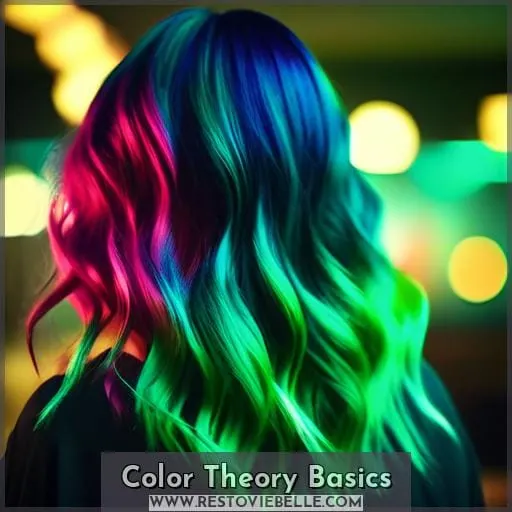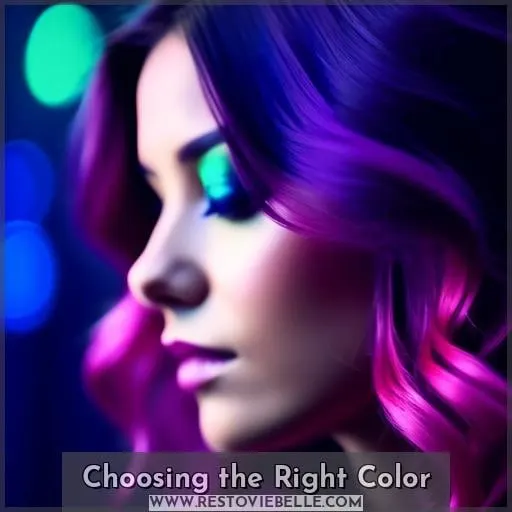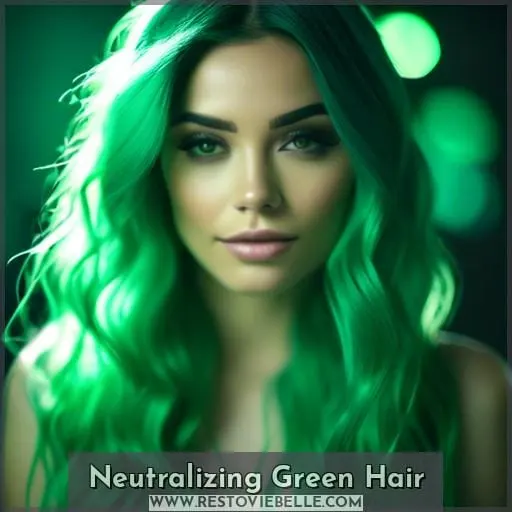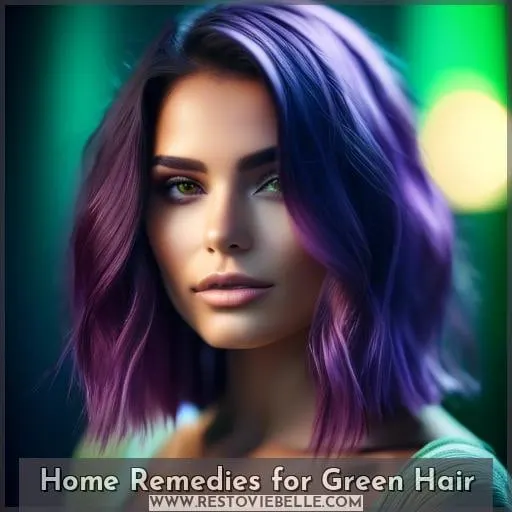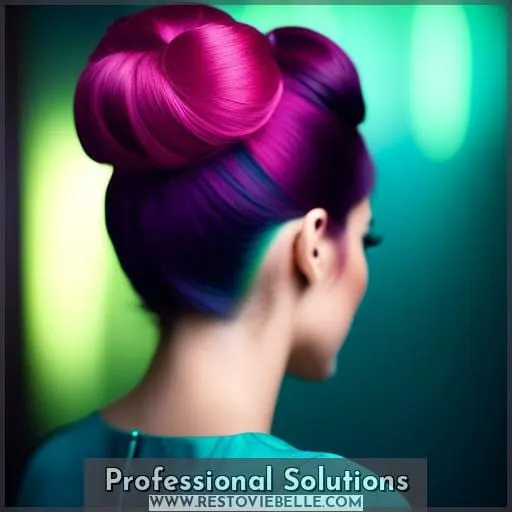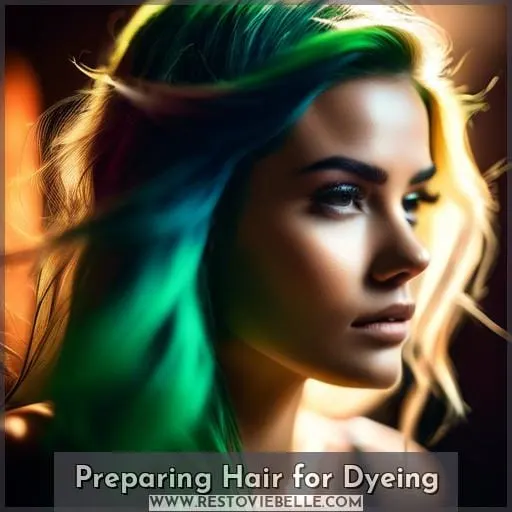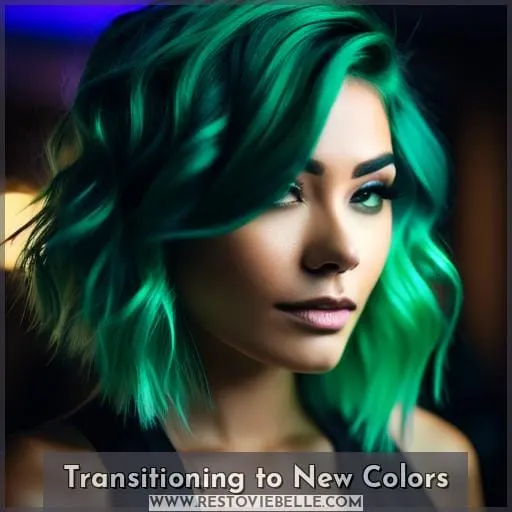This site is supported by our readers. We may earn a commission, at no cost to you, if you purchase through links.
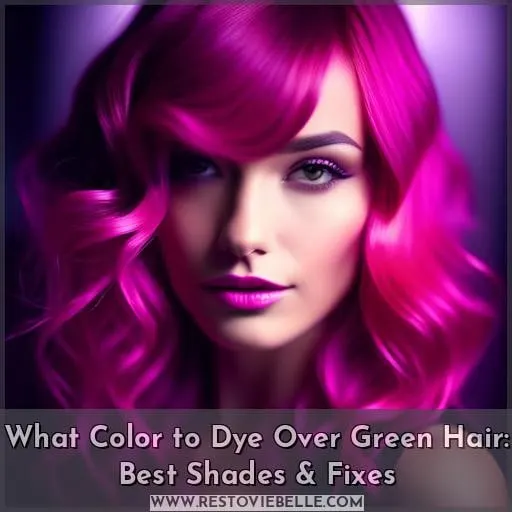 Eons ago, the quest for the perfect hair color could lead one down a path of endless shades and tones. If you’re wrestling with the aftermath of a vibrant green adventure, fear not. The art of color correction is a well-trodden path, and the key lies in understanding the color wheel.
Eons ago, the quest for the perfect hair color could lead one down a path of endless shades and tones. If you’re wrestling with the aftermath of a vibrant green adventure, fear not. The art of color correction is a well-trodden path, and the key lies in understanding the color wheel.
Whether you’re aiming to neutralize the green with hues of red and orange or transition to a completely new shade, this guide will navigate you through the best colors to dye over green hair. From the science of color theory to practical application tips, you’re about to master the transformation of your green tresses into a color that resonates with your true style.
Yes, you can dye over green hair with colors like red, brown, or orange to neutralize the green tones. Warm auburn or reddish-orange shades are particularly effective for covering green hues.
Table Of Contents
- Key Takeaways
- Color Theory Basics
- Choosing the Right Color
- Neutralizing Green Hair
- Home Remedies for Green Hair
- Professional Solutions
- Preparing Hair for Dyeing
- Application Techniques
- Aftercare and Maintenance
- Common Mistakes to Avoid
- Transitioning to New Colors
- Frequently Asked Questions (FAQs)
- How does hair porosity affect the process of dyeing green hair to another color?
- What are the potential effects of hard water on dyeing over green hair?
- Can hormonal changes impact the way hair holds or changes color after dyeing over green hair?
- How does previous hair damage influence the outcome when dyeing green hair to purple?
- What are the environmental factors that could affect the longevity of the new hair color after covering green hair?
- Conclusion
Key Takeaways
- Red tones, such as auburn, can effectively neutralize green hues in hair without the need for bleaching.
- Purple shades, including burgundy and lavender, are suitable for a dramatic color change from green, also without bleaching.
- Home remedies like ketchup, vinegar rinse, baking soda paste, and clarifying shampoo may help fade green tones before dyeing.
- For a professional approach to removing green, consulting a colorist or opting for salon color correction is recommended.
Color Theory Basics
Understanding the basics of color theory is crucial when you’re looking to change your hair color, especially when dealing with a challenging shade like green. The color wheel is an essential tool in this process, as it visually represents the relationships between colors.
It’s divided into primary, secondary, and tertiary colors, with primary colors being the foundation from which all other colors are derived. These are red, yellow, and blue, and they can’t be created by mixing other colors.
When you mix two primary colors, you get a secondary color. For example, blue and yellow make green, red and blue make purple, and red and yellow make orange. This is particularly relevant when you’re trying to neutralize green hair because, according to color theory, using a color directly opposite on the wheel can cancel out unwanted tones.
In the case of green hair, red-orange tones are its complement and can effectively neutralize greenish hues.
Moreover, understanding warm vs. cool colors can also guide you in choosing the right shade to cover green hair. Warm colors, such as reds, oranges, and yellows, can add vibrancy and warmth, while cool colors like blues and purples can provide a calming effect.
When selecting a new hair color, consider the temperature of the color—whether it’s a warm or cool shade—and how it will interact with the existing green.
A hair color wheel can be particularly useful for a colorist to determine which shades will best cover green hair. Analogous colors, which are next to each other on the wheel, can create a harmonious look, while triadic colors, which are evenly spaced around the wheel, can offer a more vibrant contrast.
In summary, when dealing with green hair, it’s important to consult the hair color wheel and apply color theory principles to select a shade that will effectively cover the green. Whether you’re aiming for a subtle change or a dramatic transformation, a solid grasp of color theory will help you achieve your desired result.
Choosing the Right Color
When choosing the right color to dye over green hair, consider using blue shades like midnight blue or pastels. Purple tones such as burgundy or lavender, orange hues like ginger or copper, various brown options including mahogany or chocolate, and red or pink for a vibrant change can effectively neutralize green tones and provide a bold, dramatic look without the need for prior bleaching.
To avoid common mistakes when coloring green hair purple, ensure you select an appropriate color. Avoid applying dye to the scalp, follow the manufacturer’s instructions on timing, choose shades that complement your skin tone, and minimize heat styling tools to maintain hair health.
Blue Options
When transitioning from green hair, diving into the world of blue hues offers a refreshing and vibrant change.
- Midnight Blue: A deep, enchanting shade that adds a touch of mystery.
- Electric Blue: For those craving a bold, eye-catching statement.
- Pastel Shades: Soft, whimsical options for a more subtle transformation.
Choosing the right blue involves understanding your current hair color and desired outcome. Whether you’re aiming for a dramatic shift or a gentle nudge into new territory, these options provide a palette for creativity.
Consult with a hair colorist to tailor your choice to your unique style and hair condition, ensuring a stunning result that complements your individuality.
Purple Varieties
When transitioning from green to purple hair, purple is an ideal choice to mask the green shade effectively. Purple highlights or full coverage can be applied without the need for prior bleaching, resulting in a vibrant color transformation.
Purple dye can be a bold and refreshing option for those seeking a dramatic change in hair color. Remember to choose a purple shade that complements your skin tone to achieve the desired look effortlessly.
Orange and Copper
Transitioning from the cool serenity of purple tones, consider the warmth of orange and copper shades for a vibrant change.
These warm colors can infuse your green hair dye with fall vibes, creating a rich tapestry of hair color trends. Orange tones, particularly ginger and copper, offer a lively contrast to green, resulting in a dynamic and inviting palette.
When selecting hair dye, ensure the orange hair dye is sufficiently pigmented to cover the green hair dye effectively. Embrace these hues for a seasonal transformation that exudes mastery and innovation in hair color.
Brown Tones
When you’re looking to transition from green to a rich brunette, consider the transformative power of brown hair dye.
Brown hues, from the deep chocolate color to the subtle ash brown effect, can effectively cancel out hair color remnants of green. Mahogany tones offer a reddish warmth, aligning with the hair color chart’s natural progression.
For a seamless hair color transformation, select hair color products that complement your current shade and desired outcome. Brunette shades are versatile and can be tailored to your unique style, whether you’re aiming for a subtle change or a complete overhaul.
Red and Pink
When considering what color to dye over green hair, red and pink shades can be particularly effective. Red overtones are known for their ability to counteract green hues, acting as a hue neutralizing agent.
If you’re dealing with unwanted green tones, a pink corrector can help achieve color balance, restoring your hair to a more natural or desired shade. For a more subtle approach, you might opt for subtle highlights that incorporate red or pink to gently adjust the overall tone of your hair.
It’s important to choose the right shade to complement your skin tone and achieve the hair coloring results you desire. Using products like red shampoo or a vinegar rinse can also aid in neutralizing green tints, while home remedies like ketchup for green hair have been known to help correct color mishaps.
Neutralizing Green Hair
When you’re looking to neutralize green hair, the color wheel is your best friend.
Applying a red or purple dye can effectively cancel out green tones, giving you a fresh new look without the need for prior bleaching.
If you’re aiming for a dramatic change, purple dye over green hair can result in a bold and vibrant color, transforming your hair with ease.
Using Red to Cancel Green
When it comes to neutralizing green tones in your hair, reaching for red is a smart move.
- Red cancels out green: On the color wheel, red and green are opposites. Applying red tones to green hair neutralizes the unwanted green, effectively canceling it out.
- No need for bleaching: Unlike other color corrections, you don’t have to bleach your hair first. Red pigment can directly neutralize green without additional lightening.
- Versatile application: You can use red shampoo, red toner, or red dye depending on the intensity of the green you’re dealing with and the result you’re aiming for.
- Immediate results: The change can be seen immediately after the application and rinsing of the red product. It’s a quick fix to a common hair dye problem.
- Accessible solutions: Products like red shampoo and red toner are readily available from various hair color brands, making it easy to find a solution that works for you.
Purple Over Green
When you’re ready to transition from green to purple hair, you’re embracing a bold color that can completely transform your look. Purple shades, especially deep ones like burgundy dye, can effectively cancel out green tones, offering a vibrant hair result without the need for prior bleaching.
This dramatic change is perfect for those craving a fresh hair color inspiration and can be achieved with a visit to a hair color salon or through a hair color consultation online, which is often available for free.
If you’re considering this change, it’s essential to select a purple shade that complements your skin tone and to apply the dye carefully to avoid common mistakes, such as uneven color or damage from over-processing.
The right purple hue can give you a bold color that stands out, and with proper aftercare, your vibrant hair can maintain its luster and depth. Whether you’re looking for a complete overhaul or just some highlights, purple can be a great choice for a dramatic and stylish update to your hair.
Home Remedies for Green Hair
When dealing with green hair, especially after swimming in chlorinated pools, home remedies can be surprisingly effective.
You can use ketchup, vinegar rinse, baking soda paste, or clarifying shampoo to help remove the green tint from your hair.
These methods leverage the principles of color neutralization and deep cleansing to restore your hair’s natural color without the need for harsh chemicals or professional intervention.
Ketchup Method
When tackling the challenge of neutralizing green hair, the ketchup method emerges as a surprisingly effective home remedy. This technique leverages the color neutralizing effect inherent in the color theory—red dye on green hair can significantly diminish the unwanted green tinge.
By applying ketchup, which contains red pigments, directly to the green areas of your hair, you engage in a simple yet innovative approach to hair color correction. The acidity and red coloring in ketchup work together to counteract the green, leading to a noticeable color change without the need for professional hair color consultation at a salon.
This method not only offers a practical solution for those seeking to adjust their hair color from the comfort of their home but also exemplifies how everyday items can be repurposed for hair care. Whether you’re unable to schedule a hair color consultation appointment or simply prefer a DIY approach, using ketchup as a hair staining remedy underscores the potential of creative solutions in achieving desired hair color outcomes.
Vinegar Rinse
After exploring the ketchup method for neutralizing green hair, let’s dive into the vinegar rinse.
This technique shines for its simplicity and effectiveness. By mixing vinegar with water, you create a solution that not only helps remove unwanted color deposits but also enhances your hair’s natural shine.
It’s a perfect follow-up to clarifying shampoo, especially if you’re alternating with a hydrating shampoo to maintain hair health.
Whether you’re consulting a colorist at home or seeking advice online for free, incorporating a vinegar rinse can be a cost-effective step in your hair care routine, offering a brilliant blend of color correction and luster restoration.
Baking Soda Paste
To effectively neutralize and remove the green tint from your hair using a baking soda paste, follow these simple and expert-recommended steps. Baking soda, known for its neutralizing properties, can be a game-changer in your hair care routine, especially when dealing with unwanted green hues.
- Create a Paste: Mix a quarter to half a cup of baking soda with enough water to form a thick paste.
- Apply Thoroughly: Coat the green areas of your hair with the paste, ensuring even coverage. Gently massage it into your hair to maximize its effectiveness.
- Rinse and Repeat: After applying, rinse your hair with clean water. Depending on the severity of the green tint, you may need to repeat this process a few times for the best results.
- Shampoo and Condition: Once all the baking soda is rinsed out, shampoo and condition your hair as normal. This step is crucial for maintaining the health of your hair after the treatment.
- Monitor Hair Health: While baking soda is effective in removing green tints, it’s important to use it sparingly. Overuse can lead to dryness and brittleness due to its high alkalinity.
By following these steps, you can effectively remove the green tint from your hair, restoring its natural beauty. Remember, for any hair color correction or if you’re unsure about the process, consulting with a hair color consultation online expert or professional can provide personalized advice and ensure the health of your hair.
Clarifying Shampoo
To tackle green hair, clarifying shampoo emerges as a potent solution, adept at stripping away unwanted color and restoring hair health.
This shampoo delves deep, removing buildup and ensuring your blonde bits regain their luster. It’s a cornerstone in color correction, especially when transitioning from green to more natural tones.
However, it’s crucial to balance its use to prevent over-drying, safeguarding the vibrancy and health of your hair.
Professional Solutions
When dealing with unwanted green tones in your hair, consulting a professional colorist and considering salon color correction are crucial steps towards achieving your desired hair color.
A colorist can provide expert advice on the best shades to cover green hues effectively, ensuring a balanced and appealing result.
Salon color correction offers a comprehensive approach, utilizing professional techniques and products to adjust and correct the green tones, tailoring the solution to your specific hair condition and color goals.
Consulting a Colorist
After experimenting with home remedies for green hair, such as ketchup or vinegar rinses, you might still be seeking a more reliable solution.
- Colorist Knowledge: They possess a deep understanding of color theory and can select the perfect shade to neutralize unwanted green tones.
- Professional Color Correction: Colorists are skilled in correcting color mishaps with techniques that minimize further damage to your hair.
- Hair Damage Assessment: Before proceeding, they’ll assess the condition of your hair to ensure the chosen method won’t exacerbate any existing damage.
- Personal Color Analysis: A colorist can perform a personal color analysis to determine which shades will complement your natural features, leading to a custom color formulation that’s unique to you.
By relying on a colorist’s expertise, you can achieve the desired purple hue over your green hair with confidence, knowing that the health of your hair and its appearance are in capable hands.
Salon Color Correction
After consulting with a colorist, you might decide that salon color correction is your best bet for dealing with green hair. Professional colorists have a range of color correction techniques at their disposal, from bleaching green dye out of your hair to performing root touch-ups and addressing color fading issues.
They can also help repair hair damage that might’ve occurred during your color adventures.
Here’s a quick guide to what you can expect during a salon color correction:
| Service | Description |
|---|---|
| Bleaching | Professionals can safely remove green dye, preparing your hair for a new color. |
| Root Touch-Ups | Address new growth and ensure an even color from roots to ends. |
| Color Fading | Correct uneven fading and restore vibrancy to your hair. |
| Hair Damage Repair | Treatments to help restore the health of over-processed hair. |
Preparing Hair for Dyeing
When preparing to dye over green hair, it’s crucial to start with a clean slate. Washing and thoroughly drying your hair ensures that the dye adheres evenly, avoiding patchy results.
Sectioning your hair into manageable parts not only simplifies the application process but also ensures thorough coverage, setting the stage for a successful color transformation.
Washing and Drying
After consulting with a professional for the best approach to color correction, it’s time to prepare your hair for dyeing. Proper preparation is key to achieving the best results and maintaining the health of your hair.
- Washing Hair: It’s generally recommended not to wash your hair immediately before dyeing. Natural oils can protect your scalp and hair during the dyeing process. Aim to wash your hair a day or two before applying dye.
- Towel Drying: After washing, gently towel dry your hair. Opt for a microfiber towel to minimize frizz and breakage, especially if you have curly or delicate hair.
- Air Drying vs. Blow Drying: If time allows, air drying is a gentle option that avoids heat damage. However, if you’re short on time, blow drying on the lowest heat setting can be beneficial. It’s crucial to use a heat protectant to shield your hair from potential heat damage.
Sectioning for Application
When preparing to dye your hair, especially when transitioning from green to another color like purple, achieving even coverage and color saturation is crucial.
First, ensure your hair is thoroughly washed and dried, avoiding the use of heat styling tools to prevent damage. Begin by using a rat-tail comb to part your hair down the middle, from the forehead to the nape of your neck.
This initial parting creates two main sections. Next, create a crosswise part from ear to ear, dividing your hair into four manageable sections. This methodical approach allows for precise application of the dye, ensuring no strand is missed and the color is evenly distributed.
By sectioning your hair and considering its porosity, you’re setting the stage for a successful color transformation, minimizing the risk of uneven color or unsatisfactory saturation.
Application Techniques
When considering dyeing your green hair to a different color, it’s crucial to understand the mixing of dye and timing the process for optimal results.
Mixing the correct ratio of dye to developer is essential; typically, a 1:1 or 1:2 ratio is used, depending on the desired outcome and the manufacturer’s instructions.
Timing is equally important, as leaving the dye on for too long or not long enough can lead to unsatisfactory results. The usual processing time for hair dye is between 35-40 minutes, allowing for the color to fully penetrate and develop.
Properly mixing and timing your hair dye application can transform your look with vibrant, even color.
Mixing Dye
Once you’ve prepped your hair, it’s time to mix your dye. Precision is crucial when blending colors to avoid hair damage and achieve the desired color intensity.
For color correction, consider the mixing ratios provided by the dye manufacturer to ensure proper color blending. If you’re aiming for a specific shade, adjust the mix to either deepen or lighten the color.
For instance, adding conditioner to the dye can create a pastel effect but may also reduce the color’s longevity. Conversely, increasing the dye’s processing time can enhance color intensity and staying power.
Always remember to use non-metallic bowls and utensils to prevent any reaction with the dye. With careful mixing, you can transform your green hair into a vibrant purple without compromising hair health.
Timing the Process
Once you’ve selected the perfect purple shade to cover your green hair, it’s crucial to nail the timing of the dyeing process. Begin by applying the dye to your hair, section by section, ensuring even coverage.
The duration the dye should remain on your hair is dictated by the manufacturer’s instructions, so it’s essential to follow this guidance closely. Typically, the application process can take around 35 to 40 minutes. However, this can vary depending on the intensity of the color you’re aiming for and the type of dye you’re using.
Keep an eye on the clock to avoid overprocessing, which can lead to damage. Once the time is up, rinse your hair thoroughly to reveal your vibrant new purple hue.
Aftercare and Maintenance
After dyeing your hair to cover green tones, it’s crucial to maintain the vibrancy and health of your new color.
To do this, you should avoid heat styling as much as possible, as it can cause the color to fade and damage your hair.
Instead, opt for color-safe products that are formulated to protect and extend the life of your dyed hair.
These steps will help ensure your new hue stays as fresh and vibrant as when you first dyed it.
Avoiding Heat Styling
After you’ve dyed your hair, it’s crucial to maintain its health and vibrancy.
One significant aspect of aftercare involves minimizing heat styling, which can lead to heat damage, split ends, hair breakage, color fading, and increased dryness. Heat styling tools, such as blow dryers, straighteners, and curling irons, can strip moisture from your hair, making it more susceptible to damage.
To protect your newly colored locks, consider air drying your hair whenever possible. If you must use heat, always apply a heat protectant spray beforehand to create a barrier that helps minimize damage.
Additionally, opt for the lowest heat setting that will still achieve your desired style to reduce the risk of harming your hair.
By taking these precautions, you can help preserve the health and color of your hair, ensuring it remains vibrant and strong.
Using Color-Safe Products
After dyeing your hair, especially with vibrant or unconventional colors, maintaining that fresh, vivid look is crucial.
To keep your newly dyed hair looking its best, invest in color-safe shampoos and conditioners. These products are specifically formulated to gently cleanse your hair without stripping away the dye.
Additionally, incorporating color-protecting sprays and leave-in treatments into your routine can shield your hair from UV damage and prevent color fading.
For deeper nourishment, consider using hair masks designed for color-treated hair. These masks can help repair damage and keep your hair color looking vibrant for longer.
Common Mistakes to Avoid
When attempting to change your green hair color, it’s crucial to avoid common pitfalls that can lead to unsatisfactory results or damage.
Firstly, selecting the wrong color can exacerbate the issue rather than solve it. It’s essential to understand color theory and choose a shade that effectively neutralizes green tones.
Secondly, overprocessing your hair by leaving the dye on for too long or using excessive heat can cause significant damage. Always follow the product instructions and perform a strand test to ensure the chosen color works as intended without harming your hair.
Wrong Color Choice
When dyeing your green hair purple, it’s crucial to avoid a color mismatch, which can lead to uneven results and a shade that fades too quickly or clashes with your skin tone.
To prevent wrong application, ensure you’re using the right technique and fully saturating your hair with dye. If the color is applied unevenly, you might end up with patchy areas that don’t fully neutralize the green.
Additionally, selecting a purple shade that complements your skin tone is essential to avoid color clashes that can make your new hair color look less flattering. Remember, a successful color change isn’t just about the dye; it’s about how you use it and how well it suits you.
Overprocessing
When transitioning from green to purple hair, it’s crucial to avoid overprocessing, which can lead to hair damage and color fading. Overprocessing occurs when hair is subjected to too many chemical treatments, causing it to become weak and brittle.
To prevent this, be mindful of the timing when applying purple dye over green hair. Excessive processing can also result in uneven root growth, necessitating more frequent touch-ups.
To maintain the integrity of your hair, it’s essential to follow the manufacturer’s instructions for the dyeing process. This includes the recommended time for leaving the dye in your hair. Overextending this time can cause unnecessary stress to your strands, leading to damage.
Additionally, after dyeing, minimize the use of heat styling tools, which can exacerbate hair damage and accelerate color fading.
When planning for touch-ups, consider using products specifically designed for root growth to ensure a seamless transition between your new purple color and natural hair. These products can help extend the life of your color and reduce the need for frequent dyeing sessions.
Remember, the goal is to achieve a vibrant new hue without compromising the health of your hair.
Transitioning to New Colors
Transitioning from green hair to a new color can be an exciting way to refresh your look and express your personality.
Whether you’re aiming for natural tones or experimenting with vibrant shades, it’s important to choose the right color that complements or effectively covers the green.
Understanding color theory and selecting shades that either neutralize or enhance the existing green can lead to stunning results, ensuring a smooth and successful color transition.
From Green to Natural Tones
Transitioning from green to natural hair tones involves a careful selection of colors and techniques to ensure the health of your hair while effectively covering unwanted green undertones.
Color removal is a critical first step, with options ranging from professional color removers to home remedies like ketchup, which can significantly fade green hues.
When selecting a dye, consider shades that naturally counteract green, such as red-based colors like auburn or chestnut for a return to natural brown tones.
Toner alternatives, including pink or red shampoos, can also neutralize green undertones without the need for harsh chemicals.
Maintaining hair health throughout this process is paramount; thus, opting for nourishing treatments and avoiding excessive heat styling are essential practices.
By carefully considering dye selection and employing strategic color correction methods, you can seamlessly transition from green to more natural hair tones while keeping your hair vibrant and healthy.
Experimenting With New Shades
After transitioning from green to your natural hair color, you might be itching to explore new shades. Temporary hair dye is a fantastic way to experiment without long-term commitment.
If you’re surprised by unexpected results, don’t fret—color correction is part of the creative process. Home remedies can offer a quick fix, like using ketchup to neutralize green tones, but for more complex changes, professional advice may be invaluable.
Frequently Asked Questions (FAQs)
How does hair porosity affect the process of dyeing green hair to another color?
Hair porosity significantly influences dyeing green hair to another color.
High porosity hair absorbs dye quickly but may not retain it well, leading to faster fading.
Low porosity hair resists absorption, requiring more effort for color to take hold and possibly longer processing times.
What are the potential effects of hard water on dyeing over green hair?
Hard water can cause mineral buildup in your hair, making it harder to color over green shades effectively.
It may also lead to faster color fading and a duller appearance.
Can hormonal changes impact the way hair holds or changes color after dyeing over green hair?
Like a chameleon adapting to its environment, your body’s hormonal shifts can indeed influence how your hair reacts to dye, potentially altering the color retention or outcome after dyeing over green hair.
Hormonal changes, such as those during pregnancy, menstruation, or menopause, can affect hair’s texture, color, and how it holds dye, making your quest for the perfect shade more challenging but not impossible.
How does previous hair damage influence the outcome when dyeing green hair to purple?
Previous hair damage can make your hair more porous, affecting how it absorbs the purple dye.
Damaged hair might absorb color unevenly, leading to patchy results.
It’s crucial to condition and treat damaged hair before dyeing for the best outcome.
What are the environmental factors that could affect the longevity of the new hair color after covering green hair?
Your hair color’s longevity is at the mercy of the sun’s rays, the embrace of humidity, and the heat’s touch.
These elements conspire to fade your vibrant hues, leaving your locks longing for their former glory.
Shield them with UV protectants, embrace heat-free styling, and dance in the shade to preserve your color’s vibrancy.
Conclusion
Navigating the sea of hair color can feel like charting unknown waters, but armed with the right knowledge, you’re set to sail smoothly.
Whether you’re looking to neutralize green hair or embark on a new color adventure, understanding color theory and choosing the right shade is key.
With these tips, you’ll confidently transform your look, ensuring your hair tells your unique story.
